TWIN TEST: ROVER SD1 2600S vs. AUDI 100 5E Two ’80s upmarket executive saloons compared.
It’s amazing how time and tastes change when it comes to buying cars, as flicking through a pile of well thumbed Autocar magazines from the early 1980s revealed a headline declaring how the latest Audi saloon was set to give Rover a serious run for its money. Move on just over 30 years and Rover-badged cars have been resigned to the history books, leaving Audi as one of the main players to fill the vacuum left by the once highlyrespected Viking longboat-badged marque.
It wasn’t always like this, as the majority of UK motorists back in the late 1970s and early 1980s were still quite patriotic when it came to the cars they chose. The 1976-launched Rover SD1 3500 V8 was initially received well by the press and the introduction of the six-cylinder powered 2300 and 2600 a year later proved a hit with middle management and the all important fleet buyers.
Meanwhile, a resurgent Audi was prospering under the wing of the Volkswagen Group and the same year the covers came off the SD1, Ingolstadt-based Audi launched the restyled C2 series 100 saloon. Power for the refreshed 100 came from a fuel-injected 136bhp inline-five cylinder engine; a unit Audi claimed was ‘as smooth as a four but with the power of a six’. In 1982 Audi launched the heavily revamped 100 C3 series, one of the first production cars to be marketed for its CD aerodynamic capabilities. That was the same year Rover introduced the inline-four O-Series powered version of the SD1 along with an oil burner, while a facelift across the whole range and a steady increase in quality control kept the five-door Rover in the showroom for another four years.
ROVER 2600 SD1
By the end of 1967, an independent Rover had been absorbed into the Leyland Motor Corporation and the technically advanced Rover P6 was competing head-to-head with a similar sized offering from Triumph, a marque already owned by Leyland Motors. When it came to developing a new luxury saloon, both Rover and Triumph competed against each other to produce a suitable design to replace the P6 and the 2000/2500. Unfortunately for Triumph it was David Bache and Spen King’s five-door hatchback design that eventually won the day, a move that would eventually lead to the gradual demise of the Triumph brand. Leyland Motors would go on to merge with British Motor Holdings in 1968 to form the British Leyland Motor Corporation and with Triumph, Jaguar and Rover grouped together as part of BL’s Specialist Division in 1971, the first product of this forward thinking arrangement was developed under the code name SD1.
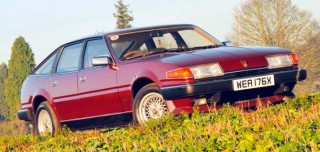
The new Rover saloon would go on to retain its Specialist Division project code name when it was unveiled in 1976 and right from the start the Rover SD1’s engine bay had been designed to receive the Buick-sourced carburettor fuelled V8 that had previously powered the company’s outgoing brick shaped P5B saloon.
The SD1 is acknowledged as being the final Rover-badged car to be designed and engineered at Solihull, the company’s ancestral home. When compared to the P6, which featured an innovative central core body structure clad with removable outer panels, the SD1 was built more simply around a traditional monocoque. Rather than utilising the P6’s sophisticated inboard discs and De Dion-type rear suspension setup, the new Rover featured a torque tube-style back axle and rear drum brakes. The SD1’s front suspension was a totally different set up from the P6’s technically innovative set up and featured MacPherson struts kept in check by a sturdy anti-roll bar.
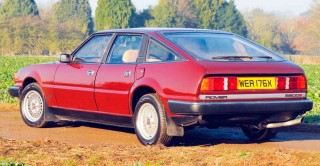
BL launched the Rover SD1 in 1976 and at £4750, this V8-powered 123mph executive express represented great value for money when compared to the more expensive five-cylinder C2 Series Audi 100. Immediately after launch, positive media publicity hyped up the SD1’s capabilities so much that second-hand examples were selling at a premium over the price of a new car. This situation didn’t last long and in late 1977 the supply situation was eased somewhat when Rover introduced the six-cylinder single OHC powered 2300 and 2600.
The SD1’s PE166 six-cylinder engine was a reworked Triumph unit but problems with these inline-sixes included camshaft failures due to poor design. Fortunately, these issues were cured on later units and the twin SU fuelled 2597cc straight six fitted to the 2600 was certainly no slouch. When compared to a V8 powered automatic SD1, the six-cylinder Rover had a top speed of 118mph. This was one mile an hour faster than an automatic V8 equipped SD1, although the big vee engine could produce 198 lbf.ft of torque at 2500rpm against the straight six’s still very respectable 152 lbf.ft at 3750rpm.
Although 1977 was the year the SD1 picked up the coveted European Car of the Year award, poor build quality that included flaking paintwork had a negative affect on sales. Along with almost continual strike action affecting delivery dates, these problems were starting to tarnish the Rover marque. Many of the SD1’s reliability issues were down to electrical faults. A high proportion of the SD1’s electrical components were supplied by Lucas and in a classic case of passing the buck, the supplier blamed BL for punishing them on price, which had a disastrous effect on quality.

Despite the SD1 range receiving a revised interior in 1980, build quality was now at an all-time low and to alleviate the problem, BL decided to move production from its strike ridden state-of-the-art Solihull plant to the former Morris Motors factory at Cowley. Once production at Cowley had settled down, SD1 quality steadily improved and in 1982 Rover launched a much needed facelifted version. Revisions to the new model included slightly restyling the front end of the car and enlarging the rear window to improve visibility. Inside the SD1’s spacious cabin, a new instrument panel now graced the top of the car’s full width dash top shelf and wood veneer was used for the first time in several versions of the big Rover.
Two important new models were added to the SD1 line up in 1982; the four-cylinder, O-Series powered Rover 2000 and the 2000SD, an oil burner using a turbocharged diesel engine built by Italian maker VM. The same year also saw the arrival of the fuel-injected V8 Vitesse and in 1984 Rover introduced the range-topping luxury Vanden Plas EFI, a model that was supposed to compete with equally sized high performance offerings from the likes of Mercedes-Benz and BMW. Build quality on the later big Rovers was a lot better than the earlier cars and SD1 production continued at Cowley until the introduction of the front-wheel drive Rover 800-series in 1986.
The Rover SD1 we’re featuring here is a 2600S automatic that’s currently owned by Dan Goff, a self confessed ‘Rover man’ who currently sells new cars at a Northamptonshire Hyundai dealership. Dan’s excellent 1982-registered 2600S (the ‘S’ only appeared on early versions) has 57,500 miles on its odometer and a large history file backs up the Rover’s low mileage. A close examination of this SD1’s Oporto Red paintwork shows it to be excellent condition, except for a very small ding on the tailgate below the number plate where one of the car’s three previous owner made contact with a lamppost.
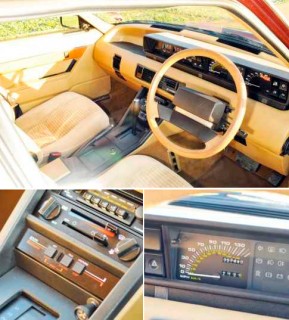
Even though this SD1 is a Cowley-built facelift model with the larger rear screen, the view while reversing is extremely limited, which probably explains the damage. Although the Rover feels a big car when sitting behind the large, thin rimmed steering wheel, power assisted steering (standard on the 2600 from 1978) makes manoeuvring in tight spaces reasonably easy. Slipping the Rover’s gear selector into the ‘D’ position with the footbrake firmly applied resulted in the needle on the rev counter falling slightly as the Rover’s Borg-Warner type 66 three-speed automatic gearbox took up the drive and prepared for action.
A quick dab on the throttle soon had this 136bhp SD1 cruising at 60mph along the A5 in a time that would have put a modern set of wheels to shame. Although the six-cylinder engine on the 2600 isn’t as refined as the 3500’s super smooth V8, it sounds good when working hard. Dan’s 2600S didn’t hang around when it hit the open road and this lucky owner reckons he gets around 23 miles out of every gallon of unleaded, which isn’t too bad for a very usable classic powered by twin SU fuelled six-cylinder engine.
AUDI 100 C2
Before we launch into discussing the Audi 100’s attributes, it’s worth taking brief look at the history of the company that designed and produced this worthy SD1 competitor. Although Audi’s four-ring badge is a relative newcomer to these shores when compared to Rover, the marque can trace its heritage back to 1889 when German engineer August Horch formed his first enterprise. After going on to found August Horch & Cie Motorwagenwerke AG near Cologne in 1904, a boardroom squabble resulted in Horch departing in 1909 and forming a new company with a similar name.
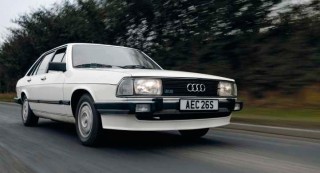
After being sued for trademark infringement, Horch changed the name of his new business to Audi, a close Latin translation of his surname, which means Hark in English. Horch ended up leaving the firm in 1920 and eight years later the owner of Dampf-Kraft Wagen (DKW) acquired the majority of Horsch’s Audiwerke. In 1932 Audi and DKW went on to merge with Wanderer and Horch’s original 1904-formed company to form Auto Union.
After the Second World War, the Auto Union factory ended up in the Russian sector and in 1949 the remains of the plundered plant was relocated to Ingolstadt in West Germany. By 1959 Daimler Benz owned 100 per cent of Auto Union and in 1964 Volkswagen acquired a 50 per cent holding of the operation. Eighteen months later VW went on to take full control of Auto Union and rather than continue to build cars under the Auto Union and DKW marques, VW resurrected the Audi badge. The first new Audi to wear the famous four-ring badge on its grille was the 1966 launched Audi 60, a development of the two-stroke powered DKW F102.
As VW was planning to use its newly acquired plant to expand Beetle production, the boss of the Wolfsburg-based vehicle manufacturer forbade any further new model development at Ingolstadt. Fearing this would be the end of the emerging Audi brand, the engineers at the former Auto Union factory under the direction of Ludwig Kraus secretly developed the first incarnation of the Audi 100. When VW’s boss, Heinz Nordhoff, was presented with a prototype, he was suitably impressed and immediately authorised the car to go into production badged as an Audi. The covers came off the front-wheel drive Audi 100 in 1968; the three numeric name of the new model’s name denoting the 100PS power output of its 1760cc north south located inline-four engine. Designated the C1 series, the suspension set up on first generation of the Audi 100 comprised of a torsion beam suspended rear axle complemented by struts and coil springs at the front.

Although Audi introduced a two-door version of thr 100 in 1969, most models imported into this country were four-door saloons. The C1 platform would go on to underpin the stylish 1.9-litre 100 Coupé S fastback, a model that many thought enjoyed a passing resemblance to the previously launched Aston Martin DBS.
Automatic transmission became available on the Audi 100 from 1970 and later models sold in Europe were equipped with the larger front and rear bumpers previously only fitted to North American export models. By this time the production line at Ingolstadt was at full stretch producing the Audi 100 and with demand outstretching supply a production line was set up at VW’s Wolfsburg plant. The manufacture of the Audi 100 at Wolfsburg made this Auto Union designed saloon the first water-cooled car to be assembled in what at the time was West Germany’s largest car plant.
This extra production helped make the C1 Audi 100 become the most successful car in the marque’s complex history and by the time C1 production came to an end in 1976, over 800,000 Audi 100’s had been produced. Audi built on the success of the C1 series with the launch of the heavily restyled C2 Audi 100 later in 1976. The new model was slightly longer than its predecessor and it’s a 1982 four-door version of the C2 100 that we’re putting up against the Rover.
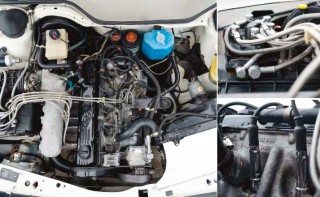
When Audi introduced the revised C2 100, it offered three engine options; a 1588cc inline-four for the home market, while export models were fitted with either a 1984 four or a 2144c five cylinder engine. The reason Audi fitted a five-cylinder engine to the new 100 was due to the engine bay not being long enough to accommodate a straight six. Five-cylinder powered 2.1-litre Audi 100’s were fuelled by a Bosch K-Jetronic fuel injection system, which gave the car a top speed of over 120mph and translated to a power output rated at 136bhp at 5700rpm. By 1977 Audi had produced a million 100s and the saloon along with the five door Avant were now being assembled at the former NSU factory at Neckarsulm as well as Audi’s Ingolstadt plant. Top of the range models were badged as the Audi 200 but only 500 right-hand drive versions of the 200 5E and the turbo-powered 5T were imported into the UK.
Although the Audi 100 was fitted with power steering as standard, driver aids such as electric windows and even a radio remained firmly on the options list. Despite the lack of creature comforts, the standard of the materials used to furnish the inside of the 100’s cabin was extremely high and the build quality was light years ahead of what Rover were achieving with even the final batch of Cowley built SD1s.
Although a basic Audi 100 was more expensive than the Rover, it was considered to be very refined and competed directly with the small executive saloons being produced by BMW and Mercedes-Benz at the start of the 1980s.The Audi 100 SE we’re matching with the Rover 2600S in this Twin Test is a 1982 model, the final year of C2 series production and belongs to Arthur Connelly, a retired heavy goods fitter who lives in Middlesbrough. Purchased new by the current owner’s father, this Audi 100 SE has remained in the family ever since and was inherited a few years ago. Despite only covering just over 52,000 miles, the Audi’s current owner has had a pair of new wings fitted to the car, as well as repairs to the inner sill area on both sides.
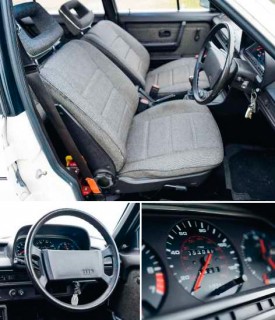
Although there were a huge number of C2 series Audi 100’s produced, surviving road worthy four-door saloons are rare in the UK. This brilliant white example appears to be in excellent condition and due to the car being garaged most of its life, the interior hasn’t suffered from any UV damage. However, even with the driver’s seat pushed right back the Audi’s cabin felt slightly more cramped than the Rover’s expansive interior, although your scribe preferred the 100’s firmer seating and more upright driving position.
This rare example was fitted with a five-speed manual gearbox and even though this 35-year old Audi received a lot of attention from fellow motorists and passers by while driving to our photoshoot in front of Middlesborough’s famous transporter bridge, the Audi felt very modern to drive. However, the Rover felt faster sprinting up to 60mph, but as the Audi had only ever been used on short journeys all its life – 12 miles in some cases – the engine and gearbox still felt tight, so comparing performance with the automatic SD1 was rather difficult.
CONCLUSION
Picking a winner from this pair of executive expresses proved very difficult and was really down to personal taste. Although the Audi 100 SE appeared to be rattle free on the move and all the doors closed with a satisfying thud, the Rover oozed charm and provided a jolt free floating ride when compared to the Audi 100’s firmer road holding characteristics.
If push came to shove, despite its doors clanging when being shut and wind noise at speed, it would be the Rover that would get my vote between these two. When parked up, the SD1 still looks modern, the Ferrari Dayton-inspired nose and deeply scalloped flanks, designed to keep the door handles clean, having stood the test of time well and received a lot of admiring glances from fellow motorists and passers by while out on our travels.
Choose the Audi if you’re a fan of Teutonic order, or go for the straight-six powered Rover if you want to get behind the wheel of a prestige saloon that could have been a world beater… if a little bit more care had been taken in building it in the first place.
OWNING THEM…
Most enthusiasts considering buying a Rover SD1 will make a beeline for the V8-powered 3500 or the later Vitesse. While the bulletproof V8 in these models produces a wonderful burble when driven hard, the straight six in the 2600 emits a characteristic sound itself and has the benefit of being lighter on fuel and cheaper to insure.
Problems with the straight six’s errant camshaft have been rectified and these engines are reasonable long lasting so long as the oil and filter has been changed regularly. Auto’ boxes on these cars are almost bullet proof and although electrics and some switchgear can be troublesome, replacement parts are available from specialist suppliers.
The downside to SD1 ownership is that body can rot just about everywhere and interior fittings tend to be frail. Like most surviving Rover SD1’s, the cloth headlining on the one we drove had fallen down in places due to the material’s foam backing breaking down. This is a relatively easy fix and a new headlining kit can be purchased from Rimmer Brothers for a tad over £250.
While four-door 100 saloons are very rare in the UK, the five-door Avant (estate) along with the two-door coupé survived in greater numbers. If you do manage to locate a four-door Series C2 Audi 100, sourcing spares can be an issue as most parts will have to come from specialists based in Germany and this can be a very expensive exercise. VW used a version of the Audi 100’s body for its Santana and although this lower specced model was always referred to as ‘the poor man’s Audi’, a scrap Santana will make a very useful donor vehicle as all the mechanical parts and a lot of the interior fittings are all interchangeable.
BUY ONE
A usable Rover SD1 2600 will cost anywhere between £4000 and £9000. Body rot is the major issue with these cars, especially on early examples as flaking paint on new cars didn’t do the SD1’s longevity any favours. Parts supply for the SD1 is excellent and there’s even an good number of body panels available to resurrect a seriously corroded SD1 – at a price.
With the number of roadworthy right-hand drive C2 series Audi 100’s down to an all time low, finding a good one is going to be a challenge. The first port of call should be the Audi Owners’ Club, as survivors will usually change hands between club members without being advertised. Prepare to pay up to £10,000 for a decent example, which will probably come with the steering wheel on the wrong side of the cabin and the speedo marked in kilometres per hour instead of miles.
| CAR | ROVER 2600 S | AUDI 100 5E C2 |
| ENGINE | 2597cc Inline-six | 2144cc Inline-five |
| TRANSMISSION | 3-speed auto | 5-speed man |
| MAX POWER | 136bhp at 5000rpm | 136bhp at 5700rpm |
| 0-60MPH | 10.7 sec | 9.5 sec |
| MAX SPEED | 118 mph | 120 mph |
| LENGTH | 469.9 cm | 479.3 cm |
| WEIGHT | 1341 kg | 1214 kg |
{CONTENTPOLL [“id”: 99]}
The Rover SD1 still looks an imposing car and a late-model 2600 makes an excellent choice. Even though this Audi 100 was a CS model and came with hard-wearing cloth upholstery, creature comforts and driver’s aids such as electric front windows all remained on the options list. The Audi 100’s Bosch-injected 2.1-litre five-cylinder engine is canted over in the engine bay and has a maximum torque of 133 lbf.ft at 4800 rpm.
“Although a huge number of C2 series Audi 100’s were produced, roadworthy survivors in the UK are rare”
“The twin SU fuelled 2597cc straight six fitted to the Rover 2600 was certainly no slouch when provoked”
Rover’s ‘PE166’ straight-six is often overlooked but is a strong performer in 2600 flavour. The SD1’s box-like instrument binnacle made it easier and cheaper to build left-hand drive versions. Materials used in the Rover’s cabin were of a decent quality and seen to have stood the test of time well.





